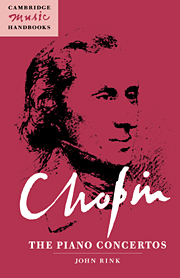Preface
Published online by Cambridge University Press: 18 December 2009
Summary
Chopin's piano concertos have enjoyed enormous popularity ever since their composition in 1829–30, but they have also suffered some of the harshest scholarly criticism inflicted on his works. Intended to launch his career as a composer-pianist, the concertos have typically been regarded in the literature as juvenilia inferior to his mature masterpieces. Nevertheless, when viewed as music to be performed rather than scores to be dissected on paper, they belong to his most successful creations, capable of evoking profound emotion in listener and pianist alike, and representative of an altogether unique, innovative pianism to be fully exploited in the composer's later music.
This handbook attempts to set the record straight, re-evaluating the concertos against the early nineteenth-century traditions that shaped them so that their many outstanding qualities can be better appreciated. After establishing such a background in Chapter 1, 1 describe the genesis of the two concertos, trace the history of Chopin's first and subsequent performances, and discuss his use of the concertos as teaching pieces in Chapter 2. An extended investigation of the critical, editorial and interpretative reception of the two works follows in Chapter 3, highlighting the contrast between initial reactions and the censure of later writers.
The fourth chapter presents an analysis based on performance related criteria. For each movement a formal outline is provided, but the principal analytical focus is on the music's temporal shaping and the role of ‘musical gesture’ in creating the powerful effect alluded to above. In a sense this study provides a rationale for the most commonly criticised elements of the two pieces – which work well in performance, however idiosyncratic they appear in the score.
- Type
- Chapter
- Information
- Chopin: The Piano Concertos , pp. ix - xPublisher: Cambridge University PressPrint publication year: 1997

